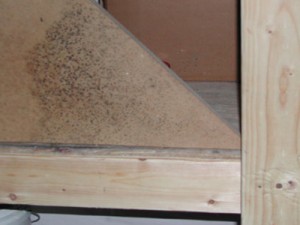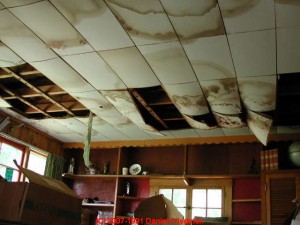 Basement ceilings are the perfect place for mold to propagate, because mold needs a cold, damp area with a lack of ventilation and sunlight. You don’t have to give up hope and have a moldy ceiling, because there are several steps you can take to get the situation under control.
Basement ceilings are the perfect place for mold to propagate, because mold needs a cold, damp area with a lack of ventilation and sunlight. You don’t have to give up hope and have a moldy ceiling, because there are several steps you can take to get the situation under control.
The first step is to control the level of moisture in your basement. If you suspect mold, you need to find anything that could be causing moisture to form or pool in the basement area. Be sure to check any carpeting and perimeter walls and if you find any areas of moisture penetration, you must deal with them properly to prevent mold from returning.
If you have basement windows, you can open them to increase air circulation. If you don’t have any basement windows, the use of an air-conditioner or dehumidifier should help dry the area out. Portable units are available for jobs that don’t require the installation of a permanent unit.
The most common place where you can find mold on your ceiling is underneath any area where water is frequently used in the house above. If you have problems with leaking appliances or busted pipes, be sure to check your ceiling for mold. If its possible you should check or replace any insulation materials in the floor and ceiling cavity, because leaving them damp will encourage mold growth. Mold typically begins growing within 48 hours of moisture saturation, but if it is in the floor or ceiling cavity you may not notice it for a long time. Install exhaust fans in your bathrooms and kitchen to cut down on the moisture that remains in those rooms.
appliances or busted pipes, be sure to check your ceiling for mold. If its possible you should check or replace any insulation materials in the floor and ceiling cavity, because leaving them damp will encourage mold growth. Mold typically begins growing within 48 hours of moisture saturation, but if it is in the floor or ceiling cavity you may not notice it for a long time. Install exhaust fans in your bathrooms and kitchen to cut down on the moisture that remains in those rooms.
You can find humidity monitors at your local hardware store, and these you can install in your basement to monitor ambient moisture. The humidity level should be below 60 percent to prevent mold from growing.
If the ceiling of your basement is at ground level, then other factors could be leading to mold growth, such as standing water around the perimeter. All downspouts and gutters need to be in good condition, and they should expel water into a drain and not the soil around your home. If you have a driveway or concrete slab at the side of your home, you should ensure it has a slight slope (at least 1 inch for every 10 feet of width) so that rainfall will run away from the walls rather than being encouraged to pool there.
Finally, you should insulate any pipes that run across your basement ceiling, preventing condensation from forming on them during the summer months. Also, check around the point where the pipe enters the basement from above for signs of mold.
